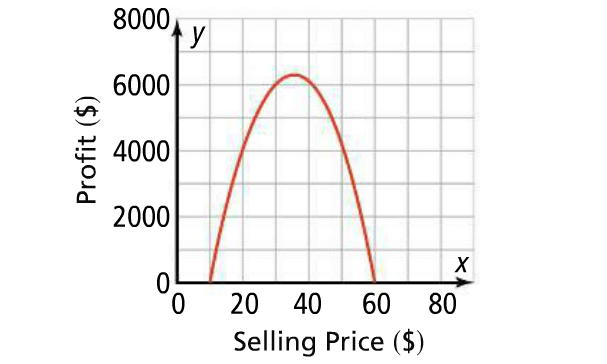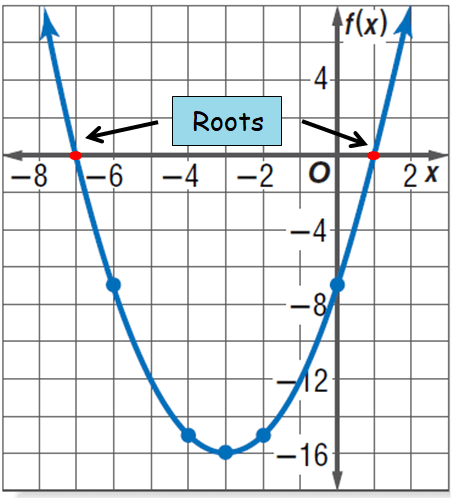WORKSHEET ON QUADRATIC EQUATIONS
Problem 1 :
Solve the following quadratic equation by factoring :
x2 - 9x + 14 = 0
Problem 2 :
Solve the following quadratic equation using quadratic formula :
15x2 - 11 x + 2 = 0
Problem 3 :
Solve the following quadratic equation by completing the square method :
x2 - 8x + 12 = 0
Problem 4 :
Solve the following quadratic equation by graphing :
x2 + 6x + 7 = 0
Problem 5 :
Write the following quadratic equation in vertex form and write its vertex :
y = -x2 + 2x - 2
Problem 6 :
Find the vertex of the quadratic equation :
y = x2 - 8x + 12
Problem 7 :
Find the value of

Problem 8 :
The graph of a quadratic function
f(x) = -10x2 + 700x - 6000
shows the profit, a company earns for selling items at different prices. Find the maximum profit that the company can expect to earn.

Problem 9 :
Find the equation of a parabola that passes through the points :
(-2, 0), (3, -10) and (5, 0)
Problem 10 :
The sides of an equilateral triangle are shortened by 12 units, 13 units and 14 units respectively and a right angle triangle is formed. Find the length of each side of the equilateral triangle.

1. Answer :
x2 - 9x + 14 = 0
Step 1 :
Multiply the coefficient of x2, 1 by the constant term 14.
1 x 14 = 14
Step 2 :
Factor 14 into two parts such that sum of the two parts is equal to the coefficient of x, -9 and the product is equal to 14.
Then, we have
14 = (-2)(-7)
Step 3 :
Using (-2) and (-7), factor the given quadratic equation and solve for x.
x2 - 9x + 14 = 0
x2 - 2x - 7x + 14 = 0
x(x - 2) - 7(x - 2) = 0
(x - 2)(x - 7) = 0
(x - 2) = 0 or (x - 7) = 0
x = 2 or x = 7
Hence, the solution is {2, -7}.
2. Answer :
15x2 - 11x + 2 = 0
Comparing ax2 + bx + c = 0 and ax2 + bx + c = 0,
a = 15, b = -11 and c = 2
Quadratic formula :
Substitute a = 15, b = -11 and c = 2.
Therefore, the solutions are
x = 2/5 and x = 1/3
3. Answer :
x2 - 8x + 12 = 0
x2 - 2(x)(4) + 42 - 42 + 12 = 0
Using the algebraic identity (a - b)2 = a2 - 2ab + b2,
(x - 4)2 - 42 + 12 = 0
(x - 4)2 - 16 + 12 = 0
(x - 4)2 - 4 = 0
Add 4 to both sides.
(x - 4)2 = 4
Take square root on both sides.
√(x - 4)2 = √4
x - 4 = ±2
x - 4 = -2 or x - 4 = 2
x = 2 or x = 6
Therefore, the solutions are
x = 2 and x = 6
4. Answer :
x2 + 6x + 7 = 0
Graph the related quadratic function f(x) = x2 + 6x + 7
Or y = x2 + 6x + 7.
Comparing y = ax2 + bx + c and y = x2 + 6x + 7,
a = 1, b = 6 and c = 7
x-coordinate of the vertex = -b/2a
Substitute a = 1 and b = 6.
x = -6/2(1)
x = -3
Substitute x = -3 in y = x2 + 6x + 7.
y = (-3)2 + 6(-3) - 7
y = 9 - 18 - 7
y = -16
Hence, the vertex is is (-3, -16)
Make a table of values to find other points to sketch the graph.
x
-8
-6
-4
-3
-2
0
2
y
9
-7
-15
-16
-15
-7
9
ordered pairs
(-8, 9)
(-6, -7)
(-4, -15)
(-3, -16)
(-2, -15)
(0, -7)
(2, 9)

Therefore, the solutions are
x = -7 and x = 1
Justification :
x2 + 6x - 7 = 0
x2 + 7x - 1x - 7 = 0
x(x + 7) - 1(x + 7) = 0
(x - 1)(x + 7) = 0
(x - 1) = 0 or (x + 7) = 0
x = 1 or x = -7
5. Answer :
y = -x2 + 2x - 2
y = -(x2 - 2x + 2)
y = -(x2 - 2 ⋅ x ⋅ 1 + 2)
y = -(x2 - 2 ⋅ x ⋅ 1 + 12 - 12 + 2)
y = -[(x - 1)2 - 12 + 2]
y = -[(x - 1)2 - 1 + 2]
y = -[(x - 1)2 + 1]
y = -(x - 1)2 - 1
Vertex form of the given equation :
y = -(x - 1)2 - 1
Comparing y = a(x - h)2 + k and y = -(x - 1)2 - 1,
(h, k) = (1, -1)
Hence, the vertex is (1, -1).
6. Answer :
y = x2 - 8x + 12
Comparing y = ax2 + bx + c and y = x2 - 8x + 12,
a = 1, b = -8 and c = 12
x-coordinate of the vertex = -b/2a
Substitute a = 1 and b = -8.
x = -(-8)/2(1)
x = 4
Substitute x = 4 in y = x2 - 8x + 12 to find the y-coordinate of the vertex.
y = 42 - 8(4) + 12
y = 16 - 32 + 12
y = -4
Hence, the vertex is (4, -4).
7. Answer :

In this question, wherever you find the pattern shown below, it can be replaced by x.

Then,
The quadratic equation above can not be solved by factoring. So, we can use quadratic formula and solve.
Comparing ax2 + bx + c = 0 and x2 - 4x - 1 = 0,
a = 1, b = -4 and c = -1
Quadratic formula :
Substitute a = 1, b = -4 and c = -1.
When we look at the given numerical expression, it is clear that its value must be greater than 4.
Therefore the value of the given numerical expression is
2 + √5
8. Answer :

The x-axis shows the selling price and the y-axis shows the profit.
The maximum y-value of the profit function occurs at the vertex of its parabola. Find the vertex of the parabola.
Use the function to find the x-coordinate and y-coordinate of the vertex.
Find the x-coordinate of the vertex.
x = -b/2a
Substitute.
x = -700/2(-10)
x = -700/(-20)
x = 35
Substitute x = 35 in y = -10x2 + 700x - 6000 to find the y-coordinate of the vertex.
y = - 10(35)2 + 700(35) - 6000
y = -12250 + 24500 - 6000
y = 6250
So, the vertex is (35, 6250).
Hence, the selling price of $35 per item gives the maximum profit of $6,250.
9. Answer :
(-2, 0), (3, -10) and (5, 0)
Step 1 :
Write the three equations by substituting the given x and y-values into the standard form of a parabola equation,
y = ax2 + bx + c
Substitute (-2, 0).
0 = a(-2)2 + b(-2) + c
0 = 4a - 2b + c
Substitute (3, -10).
-10 = a(3)2 + b(3) + c
-10 = 9a + 3b + c
Substitute (5, 0).
0 = a(5)2 + b(5) + c
0 = 25a + 5b + c
Step 2 :
Solve the system :
0 = 4a - 2b + c
-10 = 9a + 3b + c
0 = 25a + 5b + c
Solving the above system of equations using elimination method,
a = 1, b = -3 and c = -10
Step 3 :
Substitute 1 for a, -3 for b, and -10 for c in the standard form of quadratic equation.
Hence, the equation of a parabola is
y = x2 - 3x - 10
10. Answer :
Let x be the length of each side of the equilateral triangle.
Then, the sides of the right angle triangle are
(x - 12), (x - 13) and (x - 14)
In the above three sides, the side represented by (x - 12) is hypotenuse (Because that is the longest side).
Using Pythagorean theorem, we have
(x - 12)2 = (x - 13)2 + (x - 14)2
x2 - 24x + 144 = x2 - 26x + 169 + x2 - 28x + 196
x2 - 30x + 221 = 0
(x - 13)(x - 17) = 0
x = 13 or x = 17
x = 13 can not be accepted.
Because, if x = 13, the side represented by (x - 14) will be negative.
Hence, the length of each side of the equilateral triangle is 17 units.
Kindly mail your feedback to v4formath@gmail.com
We always appreciate your feedback.
©All rights reserved. onlinemath4all.com
Recent Articles
-
Trigonometry Even and Odd Iidentities
May 05, 24 12:25 AM
Trigonometry Even and Odd Iidentities -
SOHCAHTOA Worksheet
May 03, 24 08:50 PM
SOHCAHTOA Worksheet -
Trigonometry Pythagorean Identities
May 02, 24 11:43 PM
Trigonometry Pythagorean Identities

